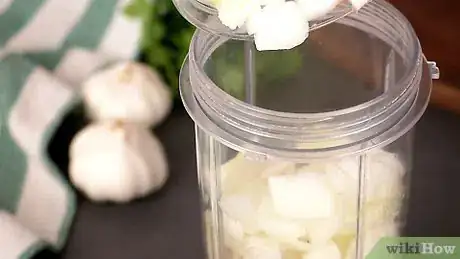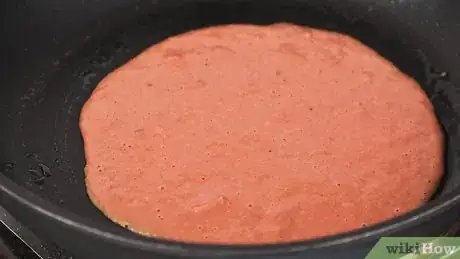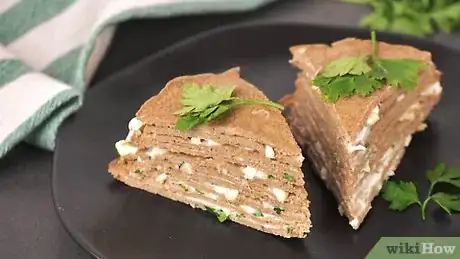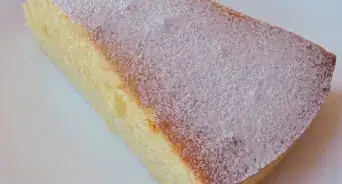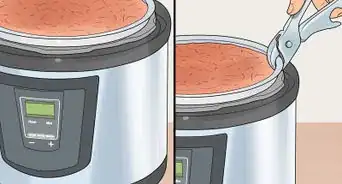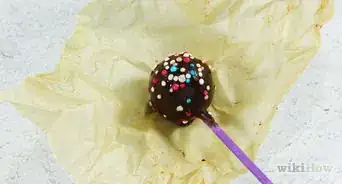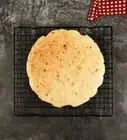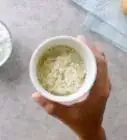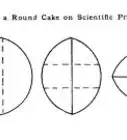This article was co-authored by wikiHow staff writer, Jessica Gibson. Jessica Gibson is a Writer and Editor who's been with wikiHow since 2014. After completing a year of art studies at the Emily Carr University in Vancouver, she graduated from Columbia College with a BA in History. Jessica also completed an MA in History from The University of Oregon in 2013.
There are 7 references cited in this article, which can be found at the bottom of the page.
The wikiHow Culinary Team also followed the article's instructions and verified that they work.
This article has been viewed 8,867 times.
Learn more...
You don't have to be a liver lover to enjoy tasty liver cakes. A liver cake is made of thinly stacked liver layers with herbed mayonnaise in between. It's traditionally served at Slavic weddings, but it also makes a great appetizer at any gathering. If you want a heartier dish, whip up some liver patties. Try this tasty liver dish the next time you're craving a burger or just want an inexpensive, nutritious meal.
Ingredients
- 1 pound (450 g) of chicken livers, cleaned
- 2 1/2 cups (287 g) of coarsely chopped yellow onion
- 4 large eggs
- 1⁄4 cup (59 ml) plus 2 tablespoons (30 ml) of corn or sunflower oil
- 1⁄4 cup (30 g) of all-purpose flour
- 2 teaspoons (11 g) of kosher salt, plus more to taste
- 1 teaspoon (2 g) of freshly ground black pepper
- 1⁄3 cup (3 g) of finely chopped fresh dill
- 2⁄3 cup (153 g) of mayonnaise
- 6 garlic cloves, finely minced
- Corn or sunflower oil for pan-frying
Makes 6 to 8 servings
- 2 1⁄4 pounds (1.0 kg) of ground calf’s liver
- 4 large Russet potatoes
- 2 large onions, grated
- 2 tablespoons (30 ml) of distilled white vinegar
- 1 cup (115 g) of cake flour
- 2 eggs
- 1 tablespoon (15 g) of baking powder
- 1 1/2 teaspoons (7 g) of salt
- Pepper to taste
- Sunflower or vegetable oil for pan-frying
Makes about 14 liver patties
Steps
Slavic Layered Liver Cake
-
1Put the livers and onion into a food processor. You can make all of the batter in a food processor or blender. Put 1 pound (450 g) of chicken livers into your machine along with 2 1/2 cups (287 g) of coarsely chopped yellow onion.[1]
- Can't find whole livers to use? It's fine to use ground livers, but you still need to put them in the blender or food processor to blend them even smoother.
-
2Pulse the onions and liver to make a thin mixture. Secure the lid on the food processor or blender and pulse until the livers are finely chopped. Keep pulsing until the mixture liquefies.[2]
- Stop the machine and scrape down the sides if pieces of liver get stuck.
Advertisement -
3Blend the liver mixture with eggs, flour, oil, salt, and pepper. Crack 4 eggs into the food processor or blender and pour in 1⁄4 cup (59 ml) plus 2 tablespoons (30 ml) of corn or sunflower oil. Then, add 1⁄4 cup (30 g) of all-purpose flour, 2 teaspoons (11 g) of kosher salt, and 1 teaspoon (2 g) of pepper. Blend the mixture for about 30 seconds or until the batter is completely smooth.[3]
- If you don't have a powerful blender or food processor, pour the liver mixture into a large bowl and put the other ingredients into it. Then, whisk them together by hand.
- Don't have corn or sunflower oil? Substitute any neutral oil like vegetable or canola oil.
-
4Heat a drizzle of oil in a skillet over medium-low heat. Set a 10 or 11 in (25 or 28 cm) nonstick skillet on the stove and drizzle about 1 teaspoon (4.9 ml) of corn or sunflower oil into it. Turn on the burner to medium-low and heat the oil until it shimmers.[4]
-
5Pour 1⁄4 c (59 ml) of batter into the skillet and tilt the pan to coat the bottom. Lift the pan off of the burner and slowly pour 1⁄4 cup (59 ml) of batter into the skillet. Tilt the pan so the batter coats the bottom.[5]
- It's really important to make the cake layer really thin so it cooks evenly.
-
6Cook the liver cake for about 3 minutes or until it's set. Place the skillet back on the burner and cook the liver cake until the sides look set and slightly crispy. Don't try to flip the layer until it's browned on the bottom.[6]
- If you'd like to cook liver cakes simultaneously, set 2 skillets on the stove so you can cook 2 layers at once.
-
7Flip the cake and cook it for 2 minutes. Take a spatula and carefully flip the thin liver cake over. If you think you'll tear the layer, it's fine to try flipping it with your fingers—just take care not to burn yourself. Once you flip the layer, cook it for 2 more minutes so it's completely cooked and browned.[7]
- To make it easier to successfully flip, slide a thin spatula underneath the edge of the layer. Once you loosen it, pull the layer up with your fingers or use a wide spatula to quickly flip the layer over.
-
8Transfer the cake to a plate and cook the remaining batter. Lay the cooked layer on a plate and pour more batter into the skillet to cook another liver layer. Keep stacking the cooked layers on the plate while you finish cooking all of the batter. Let the stack of layers cool to room temperature while you work.[8]
- Add another 1 teaspoon (4.9 ml) of oil if you notice the cakes beginning to stick to the skillet.
- You should get between 10 and 12 layers once you cook all of the batter.
-
9Mix the mayonnaise, garlic, and dill in a bowl. To make the flavorful filling for your liver cake, scoop 2⁄3 cup (153 g) of mayonnaise into a bowl and add 6 cloves of finely minced garlic. Then, stir in almost 1⁄3 cup (3 g) of finely chopped fresh dill—set a pinch aside to use as a nice garnish for the cake. Taste the filling and add as much salt and pepper as you like.[9]
- Want to make the filling in advance? Cover the bowl with plastic wrap and chill it in the fridge for up to 1 day.
- If you don't like the flavor of dill, substitute the same amount of fresh parsley.
-
10Spread filling between each layer as you stack the liver cake. Put 1 liver layer on your serving plate and spread 3 tablespoons (44 ml) of filling across it. Keep stacking layers and spreading filling until you've used all of your liver layers. Once you've spread filling on the last layer, sprinkle the pinch of dill that you reserved.[10]
-
11Cover the liver cake and chill it for at least 2 hours before you serve it. Since you don't want plastic wrap sticking to the mayonnaise mixture on top, tent the liver cake loosely with aluminum foil. Stick it in the fridge for at least 2 hours or up to 1 day so the flavors develop. You can serve slices of the liver cake chilled or warmed.[11]
- It's best to enjoy liver cake the same day you make it because it doesn't store well.
South African Liver Patties
-
1Peel and boil 4 whole Russet potatoes for 15 minutes. Rinse 4 big potatoes and peel off the skins. Then, put the whole potatoes in a large pot and fill the pot with enough cold water to completely cover the potatoes. Bring the water to a boil over medium-high heat and boil the potatoes for 15 minutes.[12]
- Don't cook the potatoes until they're soft or you'll have a hard time grating them.
- Although you can use waxy potatoes, like Yukon golds, Russets have more starch so they'll hold the patties together better.
-
2Cool the potatoes and grate them on the rough side of a box grater. Turn off the burner and scoop the potatoes out of the pot with a slotted spoon. Set them on a cutting board and let them cool until they're cool enough to handle. Then, grate them against the coarse side of a box grater.[13]
- Don't want to use potatoes? The grated potatoes help bind the patties together, but you can use 4 grated carrots instead. You may need to press them together more, but the patties will hold together even without the potatoes.
-
3Add liver, onions, vinegar, flour, eggs, baking powder, salt, and pepper. Put the grated potatoes into a big mixing bowl along with 2 1⁄4 pounds (1.0 kg) of ground calf’s liver. If you only have whole livers, grind them in a food processor before you put them into the mixing bowl. Then, add:[14]
- 2 large grated onions
- 2 tablespoons (30 ml) of distilled white vinegar
- 1 cup (115 g) of cake flour
- 2 eggs
- 1 tablespoon (15 g) of baking powder
- 1 1/2 teaspoons (7 g) of salt
- Pepper to taste
-
4Stir the meat mixture until it's combined and let it sit for 5 minutes. Use a wooden spoon or a sturdy spatula to stir all of the ingredients until they're really well mixed. You shouldn't see egg yolks or pockets of flour in your dough. Then, let the mixture rest for 5 minutes at room temperature so the flavors develop.[15]
- Your dough will be really thick, but don't worry! This just means that your patties will hold their shape when you cook them.
-
5Drizzle oil in a skillet and heat it over medium heat. Pour about 1 teaspoon (4.9 ml) of sunflower or vegetable oil into a 12 in (30 cm) heavy or nonstick skillet and turn the burner to medium. Tilt the pan to swirl the oil so it coats the bottom of the pan. Then, heat it until the oil shimmers.[16]
-
6Scoop batter into the skillet and fry the patties for 3 minutes. Dip a ladle into the batter and pour it into the hot skillet. You can probably fit 5 or 6 small patties into a 12 in (30 cm) skillet. Leave the patties to pan-fry until they're browned on the bottom—this should take about 3 minutes.[17]
- Don't want to fry the patties in batches? Save time by frying all of the patties at once on a large electric griddle.
-
7Flip the liver patties and fry them for 3 to 5 minutes. Once the patties are set on the bottom, use a flat spatula to carefully flip them over. Set the lid on the skillet and cook them for another 3 to 5 minutes or until they're tender and cooked throughout.[18]
-
8Serve the liver patties with buns, pasta, or your favorite sides. If you're substituting liver patties for hamburgers, sandwich the patties between hamburger buns and set out a variety of condiments. You could also wrap the patties in tortillas or just serve them alongside cooked pasta or steamed rice. The flavor of the liver also works well with fresh vegetables like sliced tomatoes or a garden salad.[19]
- Put leftover patties in an airtight container and refrigerate them for up to 5 days.
Things You'll Need
Slavic Layered Liver Cake
- Measuring cups and spoons
- Food processor or blender
- 10 or 11 in (25 or 28 cm) nonstick skillet
- Flat spatula
- Knife and cutting board
- Serving plate
- Ladle, optional
- Mixing bowl, optional
South African Liver Patties
- Measuring cups and spoons
- Large pot
- Box grater
- Slotted spoon
- Mixing bowl
- Spoon
- Knife and cutting board
- Blender or food processor
- Flat spatula
- Skillet or frying pan
References
- ↑ https://www.saveur.com/ukrainian-chicken-liver-pie-recipe/
- ↑ https://www.saveur.com/ukrainian-chicken-liver-pie-recipe/
- ↑ https://www.saveur.com/ukrainian-chicken-liver-pie-recipe/
- ↑ https://www.bbcgoodfood.com/user/714509/recipe/liver-cake
- ↑ https://www.enjoyyourcooking.com/appetizers-and-snacks/layered-liver-cake.html
- ↑ https://www.saveur.com/ukrainian-chicken-liver-pie-recipe/
- ↑ https://www.saveur.com/ukrainian-chicken-liver-pie-recipe/
- ↑ https://www.enjoyyourcooking.com/appetizers-and-snacks/layered-liver-cake.html
- ↑ https://www.enjoyyourcooking.com/appetizers-and-snacks/layered-liver-cake.html
- ↑ https://www.saveur.com/ukrainian-chicken-liver-pie-recipe/
- ↑ https://www.saveur.com/ukrainian-chicken-liver-pie-recipe/
- ↑ http://www.melkkos-merlot.co.za/liver-patties/
- ↑ http://www.melkkos-merlot.co.za/liver-patties/
- ↑ http://www.melkkos-merlot.co.za/liver-patties/
- ↑ https://ukrainian-recipes.com/beef-liver-cutlets.html
- ↑ https://youtu.be/Tou87a9vNlw?t=132
- ↑ https://kingrecipes.com/recipe-27-liver-patties.html
- ↑ https://kingrecipes.com/recipe-27-liver-patties.html
- ↑ https://ukrainian-recipes.com/beef-liver-cutlets.html
